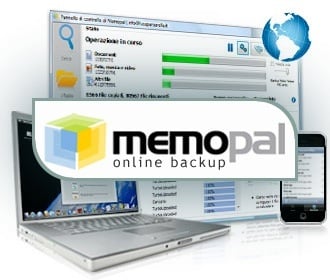
I reviewed Diino last week and while I thought that it had potential, I couldn’t really recommend using it as a primary online backup solution. I was trying out two other services at the same time, so here’s Part II of the trilogy.
Memopal is a year-old start up based in Italy, providing online backup and storage services. They have two plans for consumers: a $49 plan with 150 GBs of combined space for backups and file storage, and a $99 plan with 250 GBs.
Desktop Client
The Memopal desktop client is available for the iPhone, Linux, OS X, and Windows. Most functions are accessed through the web interface; the desktop client is sparsely featured, and exists mainly to handle back ups.
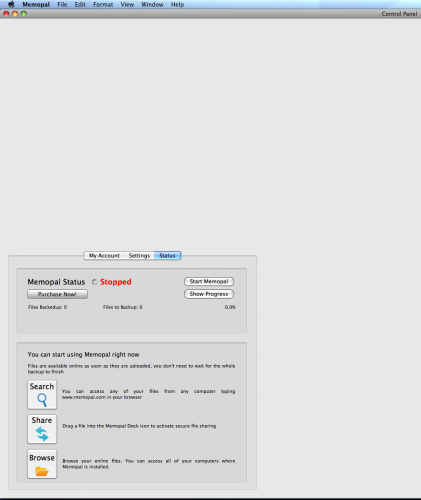
The OS X client is still in beta. It works, but there are various quirks in the user interface. The menus are non-functional (they seem to be generic TextEdit menus), and when maximized, the application window doesn’t scale properly.
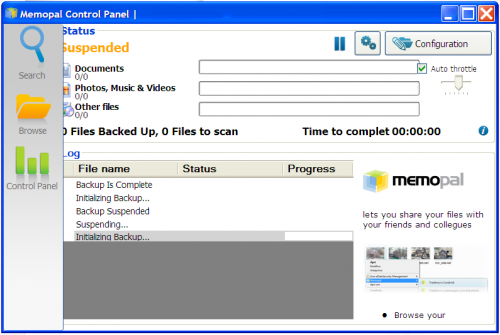
The Windows client is slightly more advanced, with a few more configuration options available.
Backing Up and Restoring
Configuring back ups is a simple process.
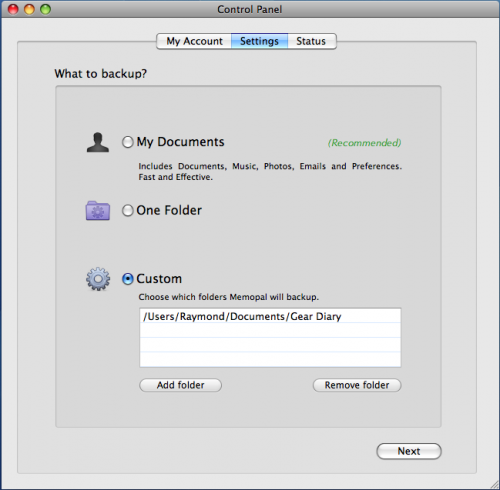
In OS X, the only options available are the choice of folders to be backed up.
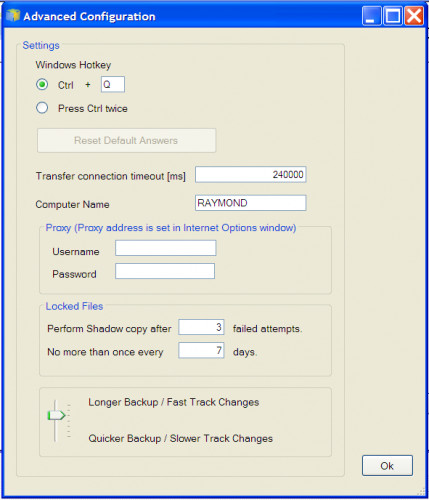
Windows users have access to advanced settings.
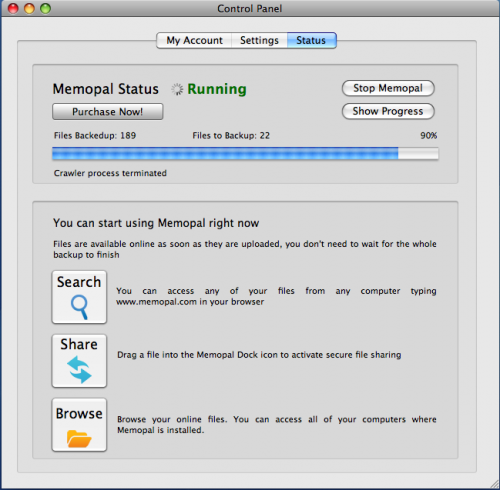
The backup process begins immediately after you make your selection – there is no option to schedule backups. Memopal says that files are monitored continuously, and the most frequently accessed files are given upload priority. In my testing, I found this to be true. Files that were modified and saved, were immediately uploaded, taking precedence over any uploads currently occurring. My test folder, measuring about 380 MBs, took several hours to upload. The transmission speed was comparable to Diino at it’s fastest (i.e. not very fast), and was inconsistent. The first 100 MBs or so were uploaded within an hour, but the upload speed then slowed dramatically.

Versioning is supported, and Memopal claims that they don’t limit the number of versions stored. Unlimited versions of files are stored for as long as your subscription is active.
Memopal takes a rather unique approach to browsing your backups. The three large buttons that say ‘Search’, ‘Share’ and ‘Browse’ are really just shortcuts. ‘Search’ and ‘Share’ take you to the web interface.
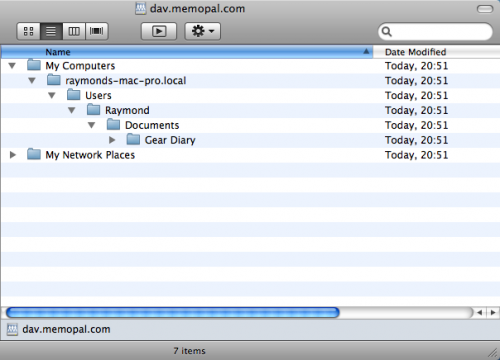
‘Browse’ opens a WebDAV folder, allowing you to browse your files using the Finder or Windows Explorer. It’s a novel approach, but one that I’m not entirely comfortable with, having had problems with WebDAV on various computers running OS X and Windows. The problem is that currently, you cannot download folders using the web interface.
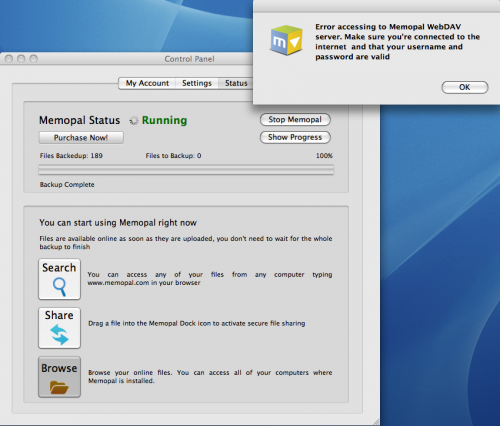
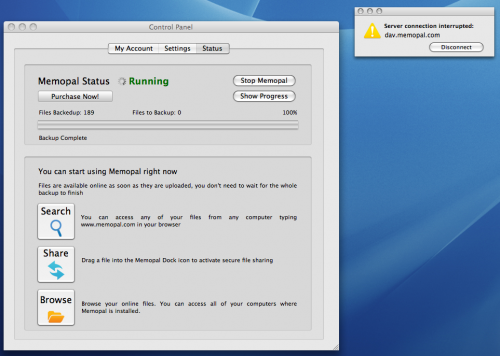
This wouldn’t be a problem if Memopal had a reliable implementation of WebDAV, but I had trouble both connecting to, and maintaining a connection with the WebDAV server. Small files would download fine, but restoring my original 380 MB folder was next to impossible because the connection to the WebDAV server kept dropping.
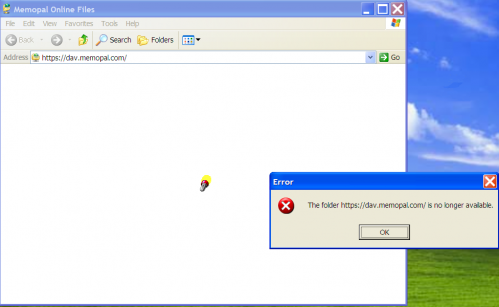
And to make doubly sure, I tried downloading the folder in Windows with the same result.
Web Interface
The Memopal web interface is where the action is. You access the web interface by clicking on the buttons in the desktop client, or logging in at the website.

Clicking on ‘Search’ takes you to the search engine. I like it. It’s a really cool feature and one that not many online backup services have. Your files are indexed as they’re uploaded (see the MGFS explanation below) and this translates to very quick search results. You can also use the default searches (Images/Music/Word/Excel/PowerPoint).

The web interface is also where you can view and download previous versions of files.
![]()
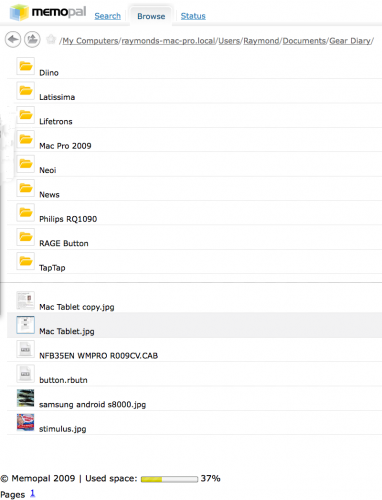
You can browse using an icon or a list view. Clicking on the arrows in the little blue boxes brings up a list of actions that you can take. Folders cannot downloaded using the web interface.
Sharing
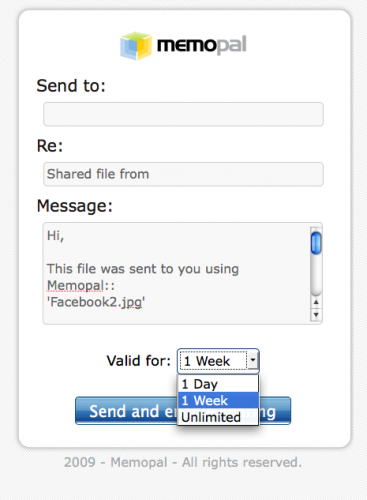
To share a file, drag it onto the ‘Share’ button in the desktop client, or select it in the web interface. An email link will then be sent to the recipient.
Mobile Access
Apart from SugarSync, I can’t remember off-hand any other online backup services that also have an iPhone client.


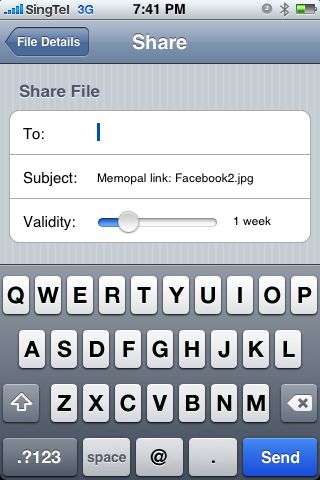
The iPhone app is basic, but useful. You can browse, view files (only those supported by the iPhone’s built in file viewer) and select files to share.
A mobile version of the web site is available for users of other mobile phones.
Security and Technology
Files are transferred over an SSL connection, and stored with 448 bit encryption. As far as I can tell, files are not compressed before uploading, but Memopal uses what it calls MGFS – Memopal Global File System. Here’s an explanation (lengthy, feel free to skip to the conclusion):
On Memopal, data is transferred encrypted by the client to the server, then saved in an encrypted File System and distributed in blocks via RAID-5 policy. MGFS inspection (Memopal Global File System) can in no way reveal the owner of the backed-up file or the name of the original file. If a storage unit were removed from the Memopal infrastructure, no amount of common sense could provide access to the saved information.
The checksum-based structure of MGFS and its cross-file compression algorithm, based on specialized vocabulary not only allows you to have a low price per Gb, but also to make your transfers faster and more secure.
They also use the term ‘geographic RAID-5’; I did a little digging, and it’s not a literal implementation of RAID-5 on their servers. Rather, when you upload a file, it gets shredded up and each shred is copied to three different servers on different continents for added protection.
If you’ve ever used services such as Streamload/TheLinkUp, you’ll remember that one of their main selling points (back in the day) was unlimited storage space. They achieved this by only storing one copy of a file, that was then shared amongst all users. For example, if you uploaded an MP3 to your account, but another user had earlier uploaded the same MP3, your file would not be stored. You’d instead be linked (invisibly) to the existing file on the server. The technology is called de-duplication, and it’s widely used by online storage services, but usually only implemented for individual users. MGFS seems to be de-duplication on a ‘global’ systemwide scale. If you’re backing up common files, such as system files and popular media (MP3s, movies, etc.) this would be useful. But not if you’re backing up personal documents.
Conclusion
Like Diino, Memopal is not quite ready for prime time. The glitchy WebDAV implementation notwithstanding, upload speeds are too inconsistent with MGFS being of dubious usefulness. Still, the company is barely a year old, and the core product shows promise.
What I Liked: Fast search engine; native OS X, iPhone client; unlimited versioning; reasonable price.
What Could Be Improved: Intermittent disconnections from WebDAV server; inconsistent upload speeds.
Pricing: $49 for 150 GBs of space; $99 for 250 GBs.